Posted on March 31 2021

By Steve Magnante on October 12, 2015 for Hot Rod
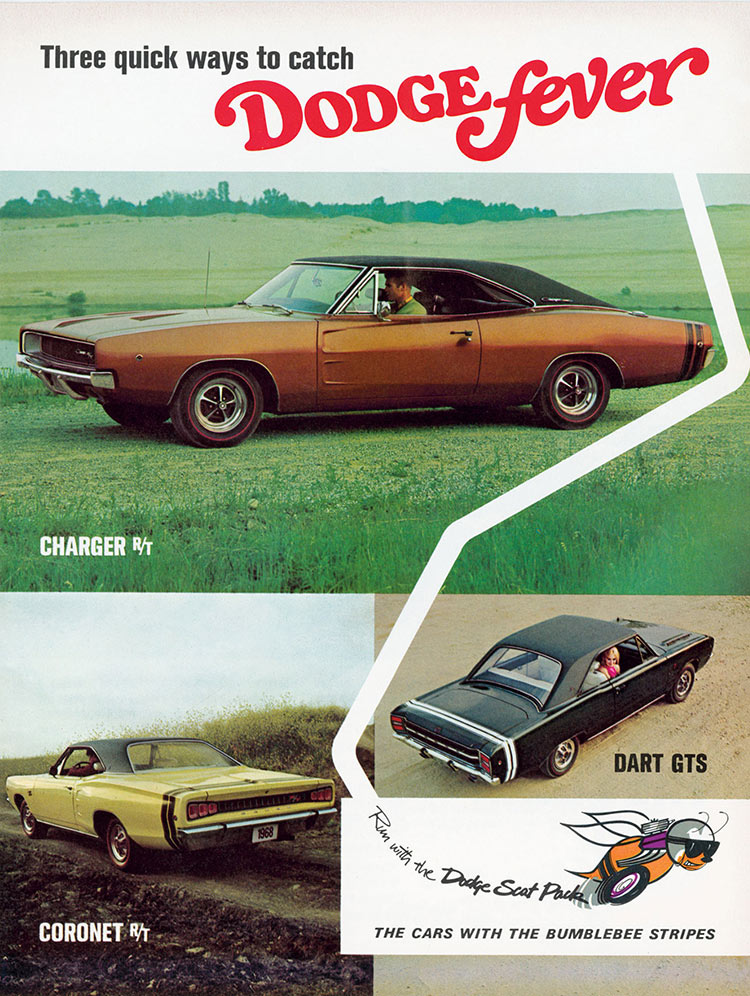
The Dodge Fever
The Dodge Fever marketing program began in 1967 and was a very successful radio, television, and print effort. But even greater creativity blossomed in 1968 with the arrival of the legendary Dodge Scat Pack theme. Both slogans appear on the front cover of this eight-page advertising insert that was bound into many enthusiast publications in late 1967 to stir interest in three all-new 1968 Dodge performance models: the Charger R/T, Coronet R/T, and Dart GTS.
Freshly redesigned for 1968 with "Coke bottle" styling, the all-new, intermediate-sized B-Body Charger R/T and Coronet R/T joined the compact Dart GTS (all-new in '67) as "the cars with the bumblebee stripes." All Scat Pack cars wore a pair of contrasting color (though generally black or white) tape stripes draped over the trunk lid and down each quarter-panel. Sure, buyers could delete the vinyl tape stripes, but most didn't.
To our knowledge, the Scat Pack program was the first of its type to gather numerous models under a common theme—thus creating an aura of exclusivity and endless opportunities for cross promotion as these crazy tail-striped muscle cars burned rubber from coast to coast. Sure, Ford had its "Total Performance" strategy in the early 1960s, but those cars bore no external unifying markings or emblems.
Chevy's Super Sport program came close. But remember, you could get an inline-250-six in any Impala SS through 1968. You paid extra for the SS396 or SS427 upgrade. By contrast, Dodge made sure any car wearing the hallowed bumblebee stripes was packing major-league heat. On the last page of this insert ad it reads, "Here's What Makes The Scat Pack Run" followed by color pictures of the 426 Hemi, 440 Magnum, and 340 (Dart GTS only). Single-exhaust systems, two-barrel carburetors, light-duty suspension systems, and six-cylinder powerplants were strictly N/A. To seal the deal, the Dodge ad gurus came up with a half car/half insect bumblebee cartoon mascot, which made its public debut on this ad in simplified form (less detail and more orange than later versions).
From a design standpoint, this color ad is attractive and depicts the trio of muscular Dodges nicely—especially that mouth-watering Turbine Bronze Charger R/T. The only distraction is that zany white line zigzagging its way down the righthand border. It's crazy until you realize it's just the contrail left by the Scat Pack Bee. Brilliant stuff! So good in fact that Dodge has recently gone back to the well with its revisiting of bumblebee mascots and vertical bumblebee stripe graphics on numerous Gen III Hemi cars and trucks.
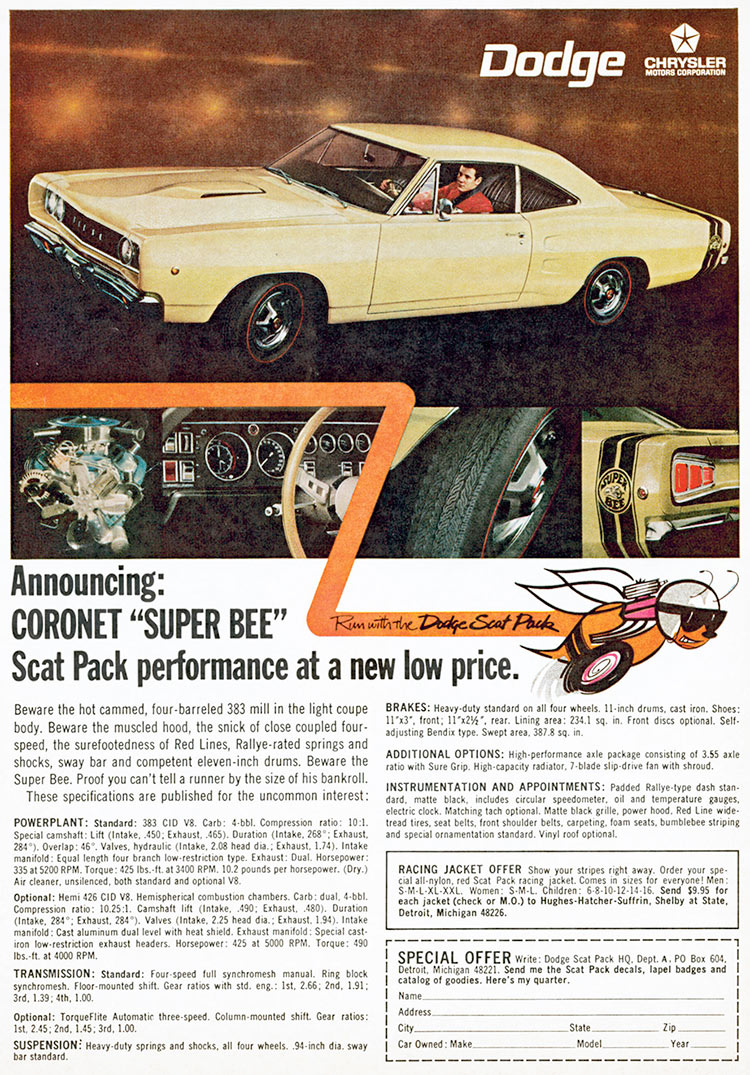
1968 Super Bee Announcement
It's easy to forget that Plymouth's 1968 Road Runner was launched months before the Dodge Super Bee. That's because nobody expected the Road Runner to succeed like it did. While Plymouth product planners figured they'd sell maybe 5,000 or 10,000 units, by the end of the year, nearly 45,000 sold, and Dodge Division wanted in on that action.
In a fast game of catch-up, Dodge stuffed its low-ball Coronet pillar coupe with pretty much the same goodies used by Plymouth: a 335hp 383 Magnum, standard four-speed (H.D. 727 automatic optional), 11-inch police-spec drum brakes, heavy-duty suspension, and minimum frills. And while Plymouth paid Warner Bros. handsomely for permission to use the Road Runner cartoon character, Dodge only had to look to its recently minted Scat Pack bumblebee mascot for inspiration. The Super Bee was born, and this ad helped spread the word.
Appearing in the Mar. 1968 edition of the big enthusiast publications, the ad copy reads: Announcing: Coronet 'Super Bee' Scat Pack performance at a new low price. With a base sticker price of $3,027, the Super Bee was $131 more costly than a comparable Road Runner. But Dodge threw in the Charger's distinctive round-gauge Rallye dash to sweeten the deal (Road Runners shared the same base-level, idiot-light dash as Slant Six Belvedere station wagons).
One big difference was that there was no hardtop model available—all 1968 Super Bees were fixed-pillar coupes, whereas Road Runners offered an optional pillarless hardtop version in 1968. Regardless, Dodge's last-minute effort snagged 7,841 customers and launched the Super Bee legend.
The art direction of this Super Bee introduction ad shares the zigzag bumblebee contrail with other Dodge Scat Pack ads and also includes a clip-out, mail-order panel offering Scat Pack decals, lapel badges, and racing jackets. Today, verifying a real 1968 Super Bee from a cloned Coronet is simple. Just check the VIN for a sequence starting with WM21.
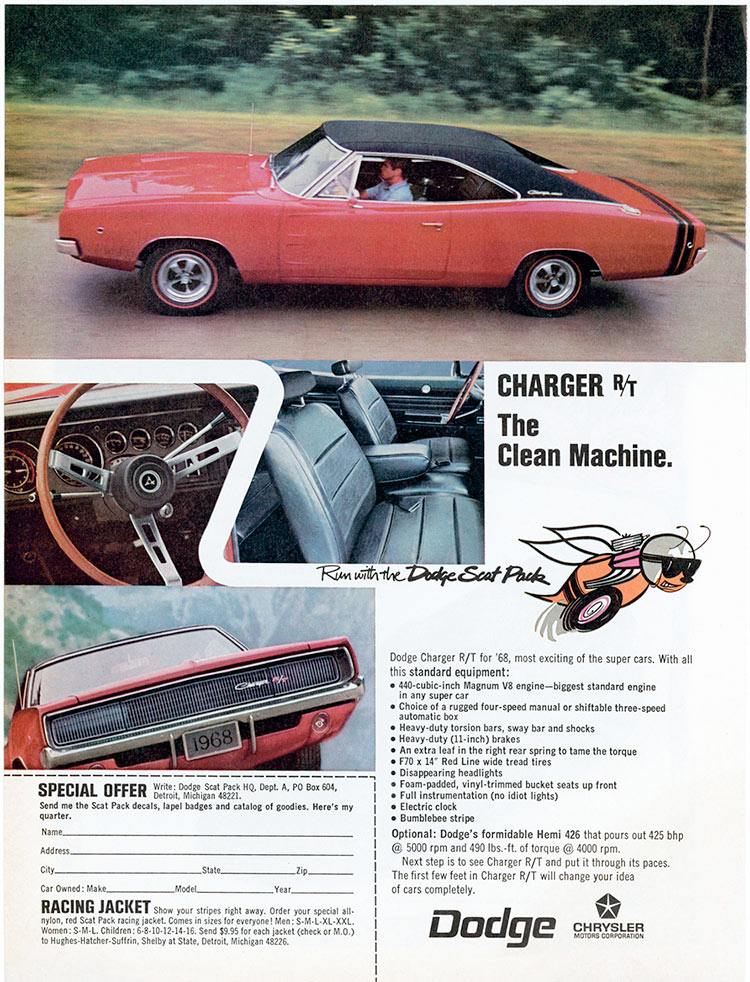
1968 Charger R/T The Clean Machine
Dodge wasn't kidding around with the Charger R/T. While competing GM supercars that year held displacement at 400 inches (excluding the limited-edition 455-inch Hurst/Olds), Dodge stuffed its 375hp, 440-cube, raised-deck big-block under the hood of every 1968 Charger R/T built. You didn't pay a dime extra. It was standard. And with its retooled exterior styling, the 1968 "Coke bottle" Charger R/T sold 17,584 units (475 with the optional 426 Street Hemi).
This ad was included in the Apr. 1968 edition of many buff books and follows the same stack-of-pictures-bisected-by-bumblebee design layout as other Scat Pack ads of early 1968. The "Clean Machine" tag line is a reference to the redesigned body. While the 1966 and 1967 Charger body was a full fastback design, for 1968 Dodge took a new semi-fastback approach and—intentionally or not—seemed to pay high tribute to the (also all-new) 1968 Corvette. The flying buttress B-pillar, sensuous fender humps, and integral tail spoiler could have you believing Dodge exterior stylists kept a step ladder propped against the back fence of the GM design center. Or was it the other way around?
Regardless, the Charger was—and is—its own car with just as deep a legend as any plastic fantastic Chevrolet two-seater. Chargers wheeled by Dandy Dick Landy, Chick DeNinno, Roland Leong, and yes, Bo and Luke Duke have forever sealed the 1968 Charger in the muscle car firmament. Naturally, the Dodge PR machine played a big part in spreading the word. Like other early-1968 Dodge Scat Pack ads, there's a clip-out, mail-in offer for Scat Pack swag—all for a shiny quarter!
One odd thing we noted about the subject car is the column-shifted TorqueFlite transmission and split bench front seat. Most Chargers (R/T or not) were built with floor shifts, consoles, and front bucket seats. Maybe the ad guys wanted to court family men with this one. This was also the sole year for all-chrome, 14-inch Magnum 500 wheels. Cheaper five-spoke wheels with clip-on stainless trim rings were adopted in 1969.
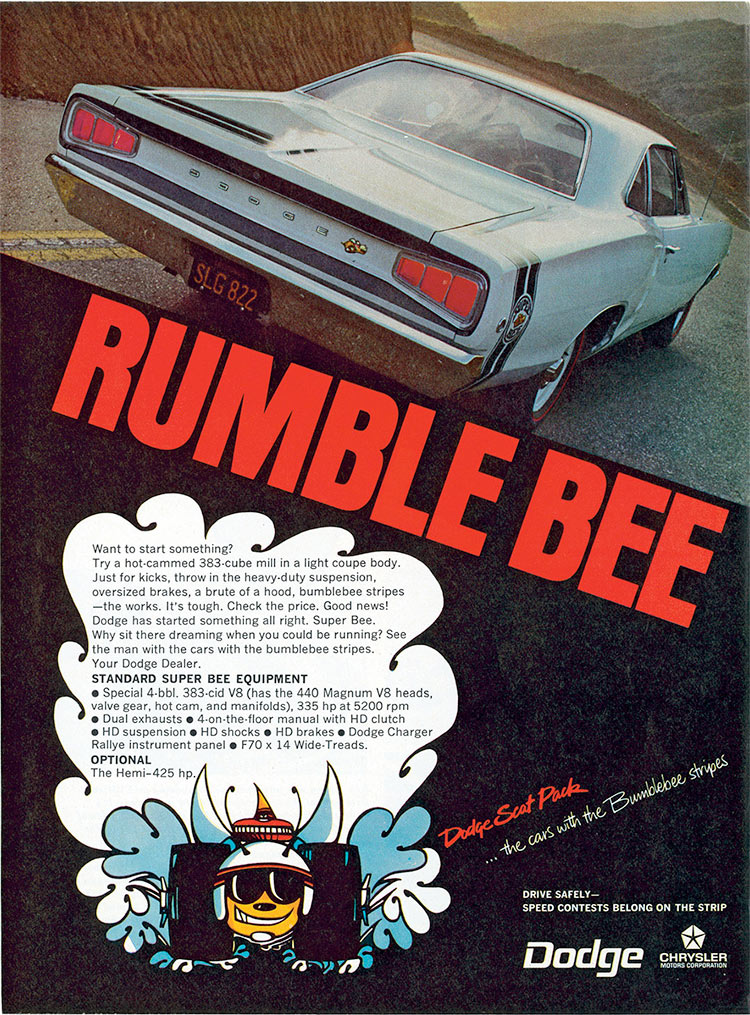
1968 Super Bee Rumble Bee
As 1968 progressed, Dodge's ad agency adopted much more aggressive design layouts. Many of the buff books featured this exciting Super Bee ad in their June 1968 editions. Gone were the busy multi-image panels and distracting bumblebee contrails. In their place was a brash new design language coupling a single dynamic vehicle image with a catchphrase. At this same time, Dodge eliminated the mail-in Scat Pack portion and gave the bumblebee a makeover with more detail and brighter colors.
Hitting the scene hot and heavy, Dodge really hyped the 1968 Super Bee with this ad. At the time, nobody could have known Dodge wouldn't even come close to catching Road Runner sales (Plymouth's budget supercar outsold Dodge's effort six-to-one in 1968), but that's the essence of advertising . . . keep trying until you succeed. Like the Super Bee announcement ad, the copy here focuses on the theme of a "hot-cammed 383 mill in a light coupe body" though the subject car here is especially Spartan with its body-colored steel wheels and bottle caps. From our vantage point, the rims appear to be 14-inchers. This likely rules out the possibility of the light-blue subject car being equipped with the optional Street Hemi (Hemis were fitted with standard 15x6 steel wheels).
This new generation of Scat Pack ads is also the first to depict the bumblebee cartoon mascot head-on. Also of note is the inclusion of subtle safety slogans, likely intended to placate an increasingly alarmed insurance industry. This one reads "Drive Safely—Speed Contests Belong On The Strip."
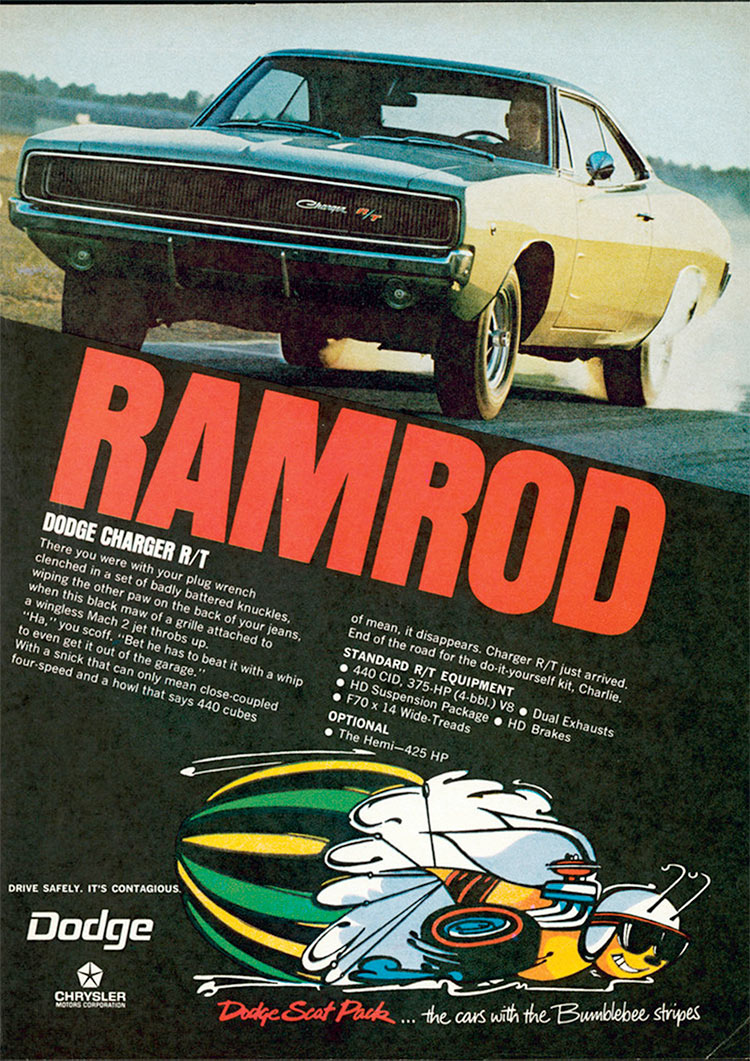
1968 Dodge Charger R/T Ramrod
By mid-1968, the Charger R/T print ad campaign was also revamped in the bold-single-image/catch-phrase mode. Appearing in the July 1968 issue of the more popular buff books, the Ramrod ad shown here is perhaps the most effective of the series. The main image—likely shot at the Chrysler Chelsea Proving Grounds—depicts a placid, light-green Charger R/T boiling the F70-14 skins into smoke. Inside, the stoic driver—wearing hip sunglasses—calmly guides the smoking missile past the camera.
Looking closely between the twin door scallops, the lack of a rectangular metal Hemi badge tells us this one's packing the standard 440 Magnum, but with 480 lb-ft of torque (just 10 clicks shy of the Street Hemi), easy mid-14s are a set of slicks away. It's no secret that old school hot rodders didn't like the trend toward factory-built muscle cars that started with the 1964 GTO.
But few could argue with the convenience of buying your hot rod rather than building it. The Ramrod ad copy brings it all home: There you were with your plug wrench clenched in a set of badly battered knuckles, wiping the other paw on the back of your jeans, when this black maw of a grille attached to a wingless Mach 2 jet throbs up. "Ha," you scoff. "Bet he has to beat it with a whip to even get it out of the garage." With a snick that can only mean close-coupled four-speed and a howl that says 440 cubes of mean, it disappears. Charger R/T just arrived. End of the road for the do-it-yourself kit, Charlie.
Details worth noting are the addition of a blossomed drag chute behind the bumblebee and a much lower stance than the cartoon used in the initial Scat Pack ads. The shading and richness of color are also improved. This time the safety slogan reads "Drive Safely. It's Contagious." We love how Dodge simply refers to the available 426 Street Hemi as "The Hemi—425 HP." 'Nuff said!

1969 Dart Swinger 340 Swinger
Dodge continued the use of vivid images and bright catchphrases rendered over black backdrops into the 1969 model year, as this 1969 Dart Swinger 340 ad illustrates. At the time, the word swinger was slang for couples with an interest in . . . sharing. It was a fairly bold move to apply it to this new-for-1969, 340-powered Dart performance model. Keep in mind, the more costly Dart GTS was still available this year (with standard 340 power but with a 383 and Hurst-massaged 440 big-blocks on deck), but, the Swinger 340 was only to be had with Chrysler's famed high-revving 340 small-block mill.
Interesting details seen in the artwork include the lack of an antenna on the passenger side front fender of this radio-delete example. You paid $62 extra for the Music Master AM radio. Also, the bumblebee cartoon is depicted from a lower than usual angle. To Dodge's credit, several renderings of the famed bee were used throughout the campaign to keep it fresh and interesting. This ad must have attracted plenty of attention, as of the 197,700 Darts built in 1969, no fewer than 16,637 were Swinger 340s—that's roughly one-in-twelve.
The safety slogan is a bit more chilling than usual. It reads "Life Is Short . . . Don't Make It Shorter. Drive Safely.
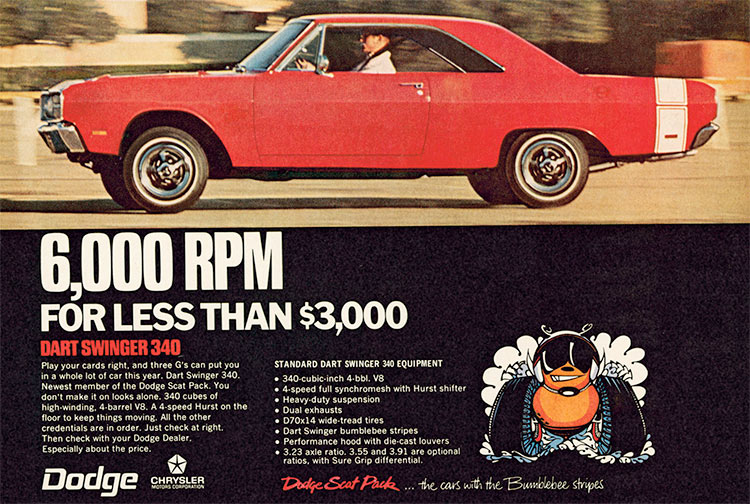
1969 Dart Swinger 340 "6,000 RPM For Less Than $3,000"
Here's another ad for the 1969 Dart Swinger 340, a more cost-conscious alternative to the Dart GTS. By trimming the fat, a base Swinger 340 could be had for an amazing $2,850—including the bulletproof A833 four-speed stick and 3.23-geared 834 rear axle in the deal. Dodge wasted little space and got right to the point with the bold white tag line reading "6,000 RPM For Less Than $3,000." It was no idle boast, as any well-tuned 340 can easily rev past 6,000 rpm with ease (four-speeds more easily than automatics, thanks to slightly hotter cam timing) all the while cranking easy mid-14s before the addition of slicks.
The subject vehicle shown in this ad is likely a preproduction engineering car, as the white tail stripe lacks the incuse Dart Swinger graphics used on regular-production models. Also note the absence of an antenna and the presence of white-line sidewalls on its D70-14 tires (red-lines were a no-cost option). The lack of a vinyl roof (a $79 option) bolsters the no-frills theme.
A quick study of the copy reveals nearly identical wording to that used in the Swinger ad—except this ad uses the term "three G's" rather than the term "three bills." Maybe some wiseguy walked into a Dodge dealer with a trio of one dollar bills and expected action. Who knows for sure? The same bumblebee graphic is shared with the Swinger ad, though its size is reduced for better balance with the rest of the page images. Also of note, this ad lacks the typical safety slogan.

1969 Super Bee Cool It
As with the Charger R/T Scat Pack ad campaign, the new, bold, slogan-over-black background design language was also employed for 1969 Dodge Super Bee ads. This one appeared in magazines dated Dec. 1968 and touts the optional new Ramcharger Air Induction System available on all 1969 Super Bees (standard on Hemis). Let's absorb the text: You're sitting watching the Christmas tree, when this thing with scoops on the hood throbs up. There're crazy stripes on the rear and some kind of bee. Goodbye. It's Super Bee. The scoops scoop. With its new Ramcharger Air Induction System, the vent opens, and a sudden rush of cool, dense air is rammed through the carburetor.
A close look at the bronze-colored feature car Bee reveals the dual-scoop Ramcharger hood option and 383 front fender emblems, which have been very intentionally accentuated via photo retouching. Also of interest is that the car is a hardtop—a new 1969 body style offering versus the pillar coupe-only 1968 Bee lineup. So did this ad have a positive impact on Super Bee shipments? You better bee-lieve it. For 1969, Dodge sold a total of 27,846 Super Bees (19,644 hardtops and 8,202 pillar coupes). That's more than a threefold increase over the 1968.
This ad also depicts the bumblebee from a front three-quarter angle, flashing that winning smile. The safety slogan reads "Safety Is No Accident. Drive With Care." We wonder what Tom Hoover, Jim Thornton, Dick Maxwell, and the rest of the original Ramchargers Dodge factory drag race team thought of Dodge's adoption of their name to describe the cold-air setup? Maybe they got a bonus.
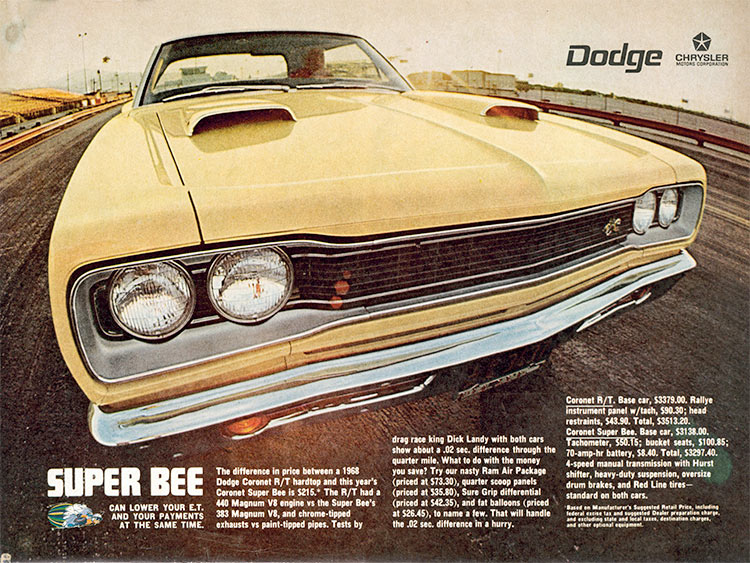
1969 Super Bee Can Lower Your E.T. And Your Payments At The Same Time
As Dodge moved further into the 1969 model year, its ad agency made yet another design format change. Gone were the black backdrop, vehicle shot, and brightly contrasting print slogan. In their place were artfully rendered, wide-angle photographs of the cars, coupled with no-nonsense text.
In the case of this 1969 Super Bee ad, which appeared in magazines with a June 1969 cover date, the copywriters make an unconventional in-family price comparison between the cost of last year's Coronet R/T and the new-for-1969 Super Bee. In part it reads: The difference in price between a 1968 Dodge Coronet R/T hardtop and this year's Coronet Super Bee is $215. The R/T had a 440 Magnum V8 engine vs the Super Bee's 383 Magnum V8, and chrome-tipped exhausts vs paint-tipped ones. Tests by drag race king Dick Landy with both cars show about 0.02 sec. difference through the quarter mile. What to do with the money you save? The ad goes on to suggest that equipping your new 1969 Super Bee with a cold-air hood ($73.30) and a sure-grip differential ($42.35) could even the score.
Comparing the base price of a 1969 Coronet R/T and Super Bee shows the Bee to cost $241 less ($3,379 versus $3,138). This ad's logic seems to have been effective, as cheaper Super Bees outsold R/Ts almost four to one (27,846 versus 7,238), 440 power or not. Not taken into account here is that by now the auto insurance industry was scrutinizing new-car purchases by young drivers. The more cubes your car had, the more you paid for insurance.

1969 Super Bee Six Pack To Go!
This 196912 Super Bee Six Pack ad appeared in buff books dated July 1969 and fired the opening salvo in the legend of the Mopar 440 Six Pack. The wide-angle, front three-quarter view is consistent with other Scat Pack ad layouts in the series. Despite appearing in numerous publications, the ad triggered the sale of only 1,907 Super Bee Six Packs (1,487 hardtops and 420 pillar coupes) in 1969. That must have been a disappointment to Dodge division, as advertising like this does not come cheap.
Then again, the A12 Six Pack (and its Road Runner 6BBL cousin) was a brash car for people with brash tastes. There were no hood hinges, no hubcaps, no A/C option, and the sole hood offering was the scooped fiberglass, flat-black, pin-on affair shown in this ad. Under the hood, an Edelbrock-sourced aluminum intake mounted a trio of Holley two-barrel carbs and, get this—a bulletproof Dana 60 rear axle was standard equipment on every 196912 Six Pack, regardless of transmission choice.
Notable extra-cost features seen on the subject car are the fender-top turn signal indicators, black vinyl roof, and front bumper guards. Conversely, the missing fender-mounted antenna signals radio-delete status, while the upright font of the Six Pack logos differs from the forward italic letters used on production models. Most likely, the Six Pack graphic was applied by a photo-retouching artist. Perhaps it's safe to say that the final logo design hadn't been finalized yet.
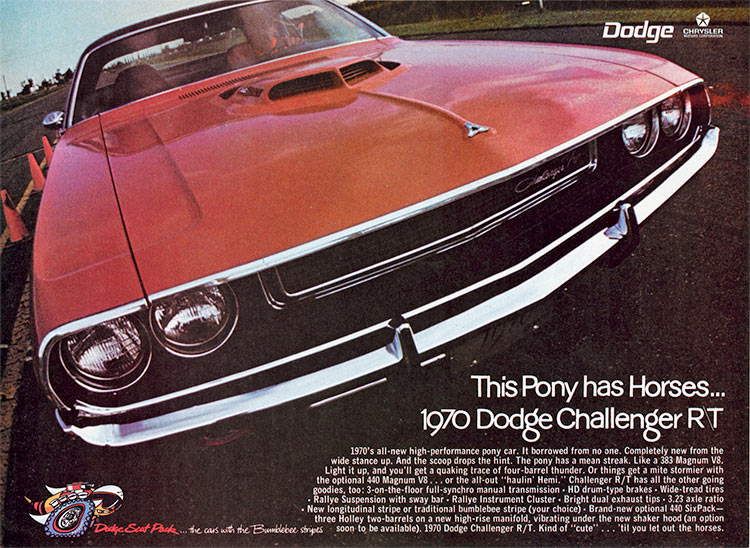
1970 Challenger R/T
Another in-your-face ad that appeared in buff magazines dated Nov. 1969 is this 1970 Challenger R/T Scat Pack shingle. It's shot with the customary Dutch camera angle and features Dodge's better-late-than-never entry into the ponycar wars. The copywriter undoubtedly had some fun with the quip, This Pony has Horses, a reference to the Challenger R/T's big-blockonly power team lineup that included everything from the 383 Magnum to the 426 Street Hemi.
But what was the effect of name checking the R/Ts various engine options in print? With the passage of time, we can quantify. Of the 19,938 Challenger R/Ts built in 1970, 13,744 got the basic 383 Magnum, 3,840 came with the 440 Magnum, 1,999 got the 440 Six Pack, and 355 were Street Hemi equipped. This seems about right considering the extra cost associated with each step up the horsepower ladder.
The Challenger featured in this ad has some unique features. The protruding bubble of its N96 Shaker hood wears 440 Six Pack emblems (which have been retouched for greater clarity), but unlike most Shaker hoods, it lacks the optional J45 chrome hoodpins. Also, the lack of an antenna mast indicates radio-delete status.
Getting back to that Shaker hood, records show that all Challenger R/Ts built prior to January 1970 (regardless of engine) wore the nonfunctional R/T power bulge hood. Note how the ad copy calls the Shaker hood "an option soon to be available." By January 1970, the Shaker hood was readily available but initially only with an Organosol black or Rallye Red bubble. By the end of 1970, Bright Blue Metallic, Astrotone Argent Silver, and semigloss black were added to the Shaker bubble color palette.
Changes made to the bumblebee Scat Pack cartoon character for 1970 included an enclosed dual-snorkel air cleaner, more realistic-looking five-spoke Road wheels, white letter markings on the tire sidewall, and a more serious grimace in place of the smile used in 1969.
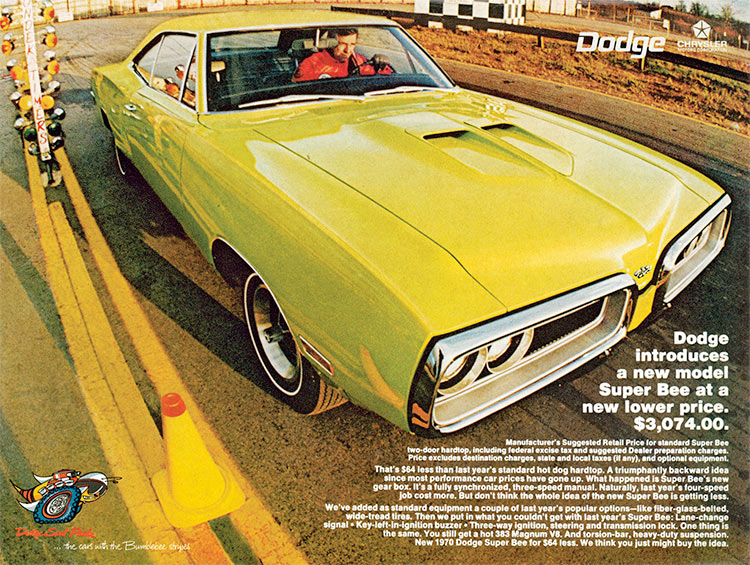
1970 Super Bee
This dramatic dragstrip-themed ad spells it out: What happened is Super Bee's new gear box. It's a fully synchronized, three-speed manual. Naturally, last year's four-speed job cost more. But don't think the whole idea of the new Super Bee is getting less. We've added as standard equipment a couple of last year's popular options—like fiber-glass-belted, wide-tread tires. Carefully crafted by the ad men, the wording implies that the better standard tires offset the loss of a forward gear. By keeping the $3, 074 base sticker price as close to the magic 3G threshold, Dodge dealers could bait-and-switch customers into the superior A833 four-speed, a hefty $198 upsell. But with its new-for-1970 Hurst Pistol Grip shifter, who could resist?
Unlike the bulletproof Borg Warner T-85 three-speed stick of the 1962-1963 Max Wedge era, the Chrysler A230 box was near its load limit with the Bee's standard 335hp, 383 big-block (naturally, the A230 wasn't available with the Bee's available 440 Six Pack or 426 Hemi). While the A230's First gear is a bit lower than the four-speed (2.55:1 versus 2.47:1) for a harder launch, the wider spacing between gears would surely dull quarter-mile acceleration by a few tenths. That's because the engine would take longer to recover lost rpm on each upshift during the sprint to the finish line.
The happy reality is that most Super Bee customers opted for the extra-cost four-speed or 727 TorqueFlite. But the ad campaign worked well enough to sell nearly 15,000 Super Bee coupes and hardtops (unlike Plymouth's Road Runner, there was no Super Bee convertible). As for engine choice, only 36 buyers took the 426 Street Hemi. The 440 Six Pack fared better, shifting 1268 units. But it is no surprise that the vast majority—12, 835 to be precise—settled for the standard 383 wedge.
Like most of the subject vehicles used in the Scat Pack ads, this 1970 Super Bee is likely a prototype or an early-build pilot line unit. Oddities include the lack of die-cast Super Bee wording on the (nonfunctional) hood dome and a clearly airbrushed Super Bee logo between the bumper hoops. The missing antenna indicates radio-delete glory, and extra light has been applied to the front tire tread. Positioned near the natural center of the page, it's intended to attract your eye to the Bee's standard, up-sized skins—all the better to help customers overlook the granny gearbox.

The Scat Pack emblems are so 70's, it's amazing. Right in the psychedelic years, they illustrate perfectly what was happening in the streets and drag strips. Be free, have fun, go fast was the spirit of the Legendary pack

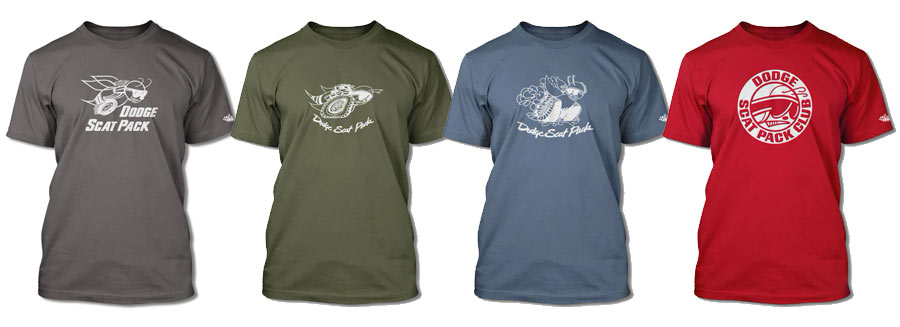



0 comments